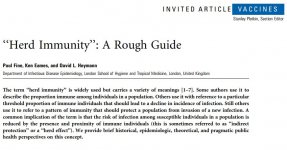David Baxter PhD
Late Founder
A Rough Guide to Herd Immunity
Debunking Denialism
October 5, 2017

How can we eradicate or control diseases? What is herd immunity and why is it important when thinking about vaccines and immunology? It turns out that vaccinations do not just protect the person getting vaccinated, but also those who cannot get vaccinated or refuse to get vaccinated.
But only up to a point. As the number of unvaccinated individuals increase, the fertile breeding ground for infectious diseases increase and will sooner or later be able to produce outbreaks. This is one of the reasons why anti-vaccine activism is so dangerous. It does not just risk individuals, but also entire populations.
Herd Immunity: A Rough Guide is a review paper on herd immunity or how having a high degree of the population vaccinated against an infectious disease will severely reduce and restrict the spread of it. It was written by Paul Fine, Ken Eames, David L. Heymann and published in the journal Clinical Infectious Diseases in 2011.
The general idea with herd immunity is that if sufficient proportion of people in a population is vaccinated against an infectious disease, it will no longer be able to spread. However, this crucially relies on the assumptions that populations are randomly mixed and that vaccine failure or refusal is also randomly distributed. Today, we know that these assumptions are not entirely accurate. This is because those who rejects vaccines tend to cluster geographically and anti-vaccine activism is correlated to many socioeconomic factors.
The article includes several classic examples of herd immunity. This includes the tendency for diseases such as measles to spark outbreak epidemics only when a certain proportion of people are susceptible, reduced number of cases of Haemophilus infections among people who are too old to have be vaccinated because younger people were vaccinated and thus less likely to spread it with nasal transmission or how influenza vaccination among younger people reduce mortality among the elderly.
This paper also goes over more sophisticated models of herd immunity, including taking into account imperfect immunity, heterogeneous populations, non-random mixing and non-random vaccinations and even the existence and influence of anti-vaccine activists. Public health efforts should not fall prey to simplistic models of herd immunity, improve monitoring of coverage, plan interventions and logistics and use careful field epidemiology knowledge.
The paper can be read freely online or downloaded as a PDF document. Cached versions of the online paper can be found here and here. A cached version of the PDF document can be found here.
This brief review paper is an excellent introduction to what herd immunity means and some of the modern complexities. It is an excellent resource to read to get up-to-date with the science of herd immunity, spread information about the importance of vaccination to those that are interested and use as a scientific source when defending science against anti-vaccine activism online.
To learn more about vaccines, check out the free vaccine textbook The Pink Book.
Debunking Denialism
October 5, 2017

How can we eradicate or control diseases? What is herd immunity and why is it important when thinking about vaccines and immunology? It turns out that vaccinations do not just protect the person getting vaccinated, but also those who cannot get vaccinated or refuse to get vaccinated.
But only up to a point. As the number of unvaccinated individuals increase, the fertile breeding ground for infectious diseases increase and will sooner or later be able to produce outbreaks. This is one of the reasons why anti-vaccine activism is so dangerous. It does not just risk individuals, but also entire populations.
Herd Immunity: A Rough Guide is a review paper on herd immunity or how having a high degree of the population vaccinated against an infectious disease will severely reduce and restrict the spread of it. It was written by Paul Fine, Ken Eames, David L. Heymann and published in the journal Clinical Infectious Diseases in 2011.
The general idea with herd immunity is that if sufficient proportion of people in a population is vaccinated against an infectious disease, it will no longer be able to spread. However, this crucially relies on the assumptions that populations are randomly mixed and that vaccine failure or refusal is also randomly distributed. Today, we know that these assumptions are not entirely accurate. This is because those who rejects vaccines tend to cluster geographically and anti-vaccine activism is correlated to many socioeconomic factors.
The article includes several classic examples of herd immunity. This includes the tendency for diseases such as measles to spark outbreak epidemics only when a certain proportion of people are susceptible, reduced number of cases of Haemophilus infections among people who are too old to have be vaccinated because younger people were vaccinated and thus less likely to spread it with nasal transmission or how influenza vaccination among younger people reduce mortality among the elderly.
This paper also goes over more sophisticated models of herd immunity, including taking into account imperfect immunity, heterogeneous populations, non-random mixing and non-random vaccinations and even the existence and influence of anti-vaccine activists. Public health efforts should not fall prey to simplistic models of herd immunity, improve monitoring of coverage, plan interventions and logistics and use careful field epidemiology knowledge.
The paper can be read freely online or downloaded as a PDF document. Cached versions of the online paper can be found here and here. A cached version of the PDF document can be found here.
This brief review paper is an excellent introduction to what herd immunity means and some of the modern complexities. It is an excellent resource to read to get up-to-date with the science of herd immunity, spread information about the importance of vaccination to those that are interested and use as a scientific source when defending science against anti-vaccine activism online.
To learn more about vaccines, check out the free vaccine textbook The Pink Book.
